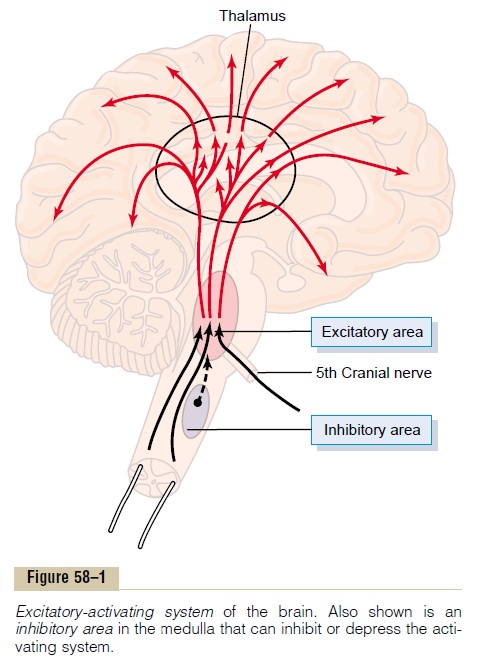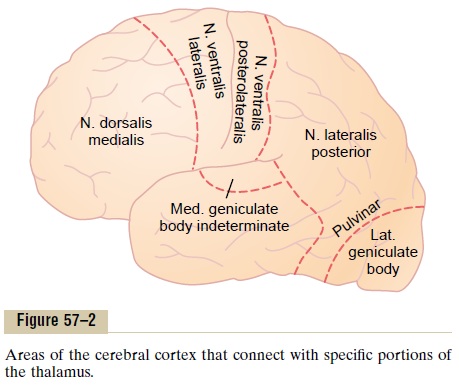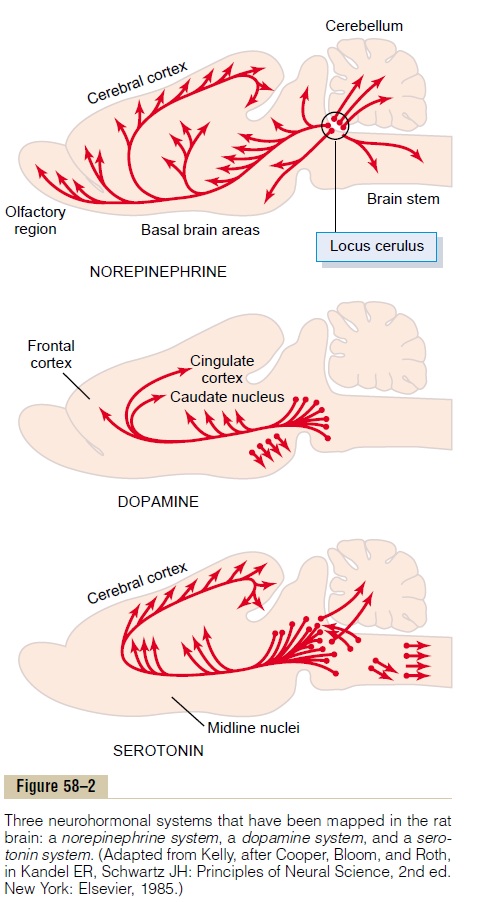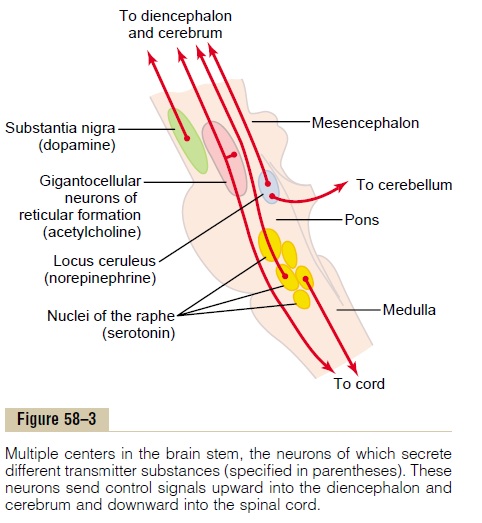Chapter: Medical Physiology: Behavioral and Motivational Mechanisms of the Brain-The Limbic System and the Hypothalamus
Activating-Driving Systems of the Brain
Activating-Driving Systems of the Brain
Without continuous transmission of nerve signals from the lower brain into the cerebrum, the cerebrum becomes useless. In fact, severe compression of the brain stem at the juncture between the mesencephalon and cerebrum, as some-times results from a pineal tumor, often causes the person to go into unremit-ting coma lasting for the remainder of his or her life.
Nerve signals in the brain stem activate the cerebral part of the brain in two ways: (1) by directly stimulating a background level of neuronal activity in wide areas of the brain and (2) by activating neurohormonal systems that release specific facilitory or inhibitory hormone-like neurotransmitter substances into selected areas of the brain.
Control of Cerebral Activity by Continuous Excitatory Signals from the Brain Stem
Reticular Excitatory Area of the Brain Stem
Figure 58–1 shows a general system for controlling the level of activity of the brain. The central driving component of this system is an excitatory area located in the reticular substance of the pons and mesencephalon.This area is also known by the name bulboreticular facilitory area. We also discuss this because it is the same brain stem reticular area that transmits facilitory signals downward to the spinal cord to maintain tone in the antigravity muscles and to control levels of activity of the spinal cord reflexes. In addition to these downward signals, this area also sends a profusion of signals in the upward direc-tion. Most of these go first to the thalamus, where they excite a different set of neurons that transmit nerve signals to all regions of the cerebral cortex as well as to multiple subcortical areas.

The signals passing through the thalamus are of two types. One type is rapidly transmitted action potentials that excite the cerebrum for only a few millisec-onds. These originate from large neuronal cell bodies that lie throughout the brain stem reticular area. Their nerve endings release the neurotransmitter substance acetylcholine, which serves as an excitatory agent, lasting for only a few mil-liseconds before it is destroyed.
The second type of excitatory signal originates from large numbers of small neurons spread throughout the brain stem reticular excitatory area. Again, most of these pass to the thalamus, but this time through small, slowly conducting fibers that synapse mainly in the intralaminar nuclei of the thalamus and in the reticu-lar nuclei over the surface of the thalamus. From here, additional small fibers are distributed everywhere in the cerebral cortex. The excitatory effect caused by this system of fibers can build up progressively for many seconds to a minute or more, which suggests that its signals are especially important for controlling longer-term background excitability level of the brain.
Excitation of the Excitatory Area by Peripheral Sensory Signals.
The level of activity of the excitatory area in the brain stem, and therefore the level of activity of the entire brain, is determined to a great extent by the number and type of sensory signals that enter the brain from the periphery. Pain signals in particular increase activ-ity in this excitatory area and therefore strongly excite the brain to attention.
The importance of sensory signals in activating the excitatory area is demonstrated by the effect of cutting the brain stem above the point where the fifth cerebral nerves enter the pons. These nerves are the highest nerves entering the brain that transmit significant numbers of somatosensory signals into the brain. When all these input sensory signals are gone, the level of activity in the brain excitatory area diminishes abruptly, and the brain proceeds instantly to a state of greatly reduced activity, approaching a permanent state of coma. But when the brain stem is transected below the fifth nerves, which leaves much input ofsensory signals from the facial and oral regions, the coma is averted.
Increased Activity of the Excitatory Area Caused by Feedback Signals Returning from the Cerebral Cortex. Not only doexcitatory signals pass to the cerebral cortex from the bulboreticular excitatory area of the brain stem, but feedback signals also return from the cerebral cortex back to this same area. Therefore, any time the cerebral cortex becomes activated by either brain thought processes or motor processes, signals are sent from the cortex to the brain stem excitatory area, which in turn sends still more excitatory signals to the cortex. This helps to maintain the level of excitation of the cerebral cortex or even to enhance it. This is a general mechanism of positive feedback that allows any beginning activity in the cerebral cortex to support still more activity, thus leading to an “awake” mind.
Thalamus Is a Distribution Center That Controls Activity in Spe-cific Regions of the Cortex. As pointed out and shown in Figure 57–2, almost every area of the cerebral cortex connects with its own highly specific area in the thalamus. Therefore, electrical stimulation of a specific point in the thalamus generally activates its own specific small region of the cortex. Further-more, signals regularly reverberate back and forth between the thalamus and the cerebral cortex, the thalamus exciting the cortex and the cortex then re-exciting the thalamus by way of return fibers. It has been suggested that the thinking process establishes long-term memories by activating such back-and-forth reverberation of signals.

Can the thalamus also function to call forth specific memories from the cortex or to activate specific thought processes? Proof of this is still lacking, but the thalamus does have appropriate neuronal circuitry for these purposes.
A Reticular Inhibitory Area Located in the Lower Brain Stem
Figure 58–1 shows still another area that is important in controlling brain activity. This is the reticular inhibitory area, located medially and ventrally in themedulla. We learned that this area can inhibit the reticular facilitory area of the upper brain stem and thereby decrease activity in the superior por-tions of the brain as well. One of the mechanisms for this is to excite serotonergic neurons; these in turn secrete the inhibitory neurohormoneserotonin at crucial points in the brain; we will discuss this in more detail later.
Neurohormonal Control of Brain Activity
Aside from direct control of brain activity by specific transmission of nerve signals from the lower brain areas to the cortical regions of the brain, still another physiologic mechanism is very often used to control brain activity. This is to secrete excitatory or inhibitoryneurotransmitter hormonal agentsinto the substanceof the brain. These neurohormones often persist for minutes or hours and thereby provide long periods of control, rather than just instantaneous activation or inhibition.
Figure 58–2 shows three neurohormonal systems that have been mapped in detail in the rat brain: (1) a norepinephrine system, (2) a dopamine system, and (3)a serotonin system.

Norepinephrine usually functions as an excitatory hormone, whereas serotonin usually is inhibitory, and dopamine is excitatory in some areas but inhibitory in others. As would be expected, these three systems have different effects on levels of excitability in different parts of the brain. The norepi-nephrine system spreads to virtually every area of the brain, whereas the serotonin and dopamine systems are directed much more to specific brain regions— the dopamine system mainly into the basal ganglial regions and the serotonin system more into the midline structures.
Neurohormonal Systems in the Human Brain. Figure 58–3 shows the brain stem areas in the human brain for acti-vating four neurohormonal systems, the same three discussed for the rat and one other, the acetylcholine system. Some of the specific functions of these are as follows:

1.The locus ceruleus and the norepinephrine system. The locus ceruleus is a small area located bilaterally and posteriorly at the juncture between the pons and mesencephalon. Nerve fibers from this area spread throughout the brain, the same as shown for the rat in the top frame of Figure 58–2, and they secrete norepinephrine. The norepinephrine generally excites the brain to increased activity. However, it has inhibitory effects in a few brain areas because of inhibitory receptors at certain neuronal synapses. We will see that this system probably plays an important role in causing dreaming, thus leading to a type of sleep called rapid eye movement sleep (REM sleep).
2.The substantia nigra and the dopamine system
It lies anteriorly in the superior mesencephalon, and its neurons send nerve endings mainly to the caudate nucleus and putamen of the cerebrum, where they secrete dopamine. Other neurons located in adjacentregions also secrete dopamine, but they send their endings into more ventral areas of the brain, especially to the hypothalamus and the limbic system. The dopamine is believed to act as an inhibitory transmitter in the basal ganglia, but in some other areas of the brain it is possibly excitatory. Also, remember that destruction of the dopaminergic neurons in the substantia nigra is the basic cause of Parkinson’s disease.
3.The raphe nuclei and the serotonin system. Inthe midline of the pons and medulla are several thin nuclei called the raphe nuclei. Many of the neurons in these nuclei secrete serotonin. They send fibers into the diencephalon and a few fibers to the cerebral cortex; still other fibers descend to the spinal cord. The serotonin secreted at the cord fiber endings has the ability to suppress pain. The serotonin released in the diencephalon and cerebrum almost certainly plays an essential inhibitory role to help cause normal sleep.
4.The gigantocellular neurons of the reticular excitatory area and the acetylcholine system.
Earlier we discussed the gigantocellular neurons (the giant cells) in the reticular excitatory area of the pons and mesencephalon. The fibers from these large cells divide immediately into two branches, one passing upward to the higher levels of the brain and the other passing downward through the reticulospinal tracts into the spinal cord. The neurohormone secreted at their terminals is acetylcholine. In most places, the acetylcholine functions as an excitatory neurotransmitter. Activation of these acetylcholine neurons leads to an acutely awake and excited nervous system.
Other Neurotransmitters and Neurohormonal Substances Secreted in the Brain. Without describing their function,the following is a list of still other neurohormonal substances that function either at specific synapses or by release into the fluids of the brain: enkephalins, gamma-aminobutyric acid, glutamate, vasopressin, adrenocorticotropic hormone, epinephrine, histamine, endorphins, angiotensin II, and neurotensin. Thus, there are multiple neurohormonal systems in the brain, the activation of each of which plays its own role in controlling a different quality of brain function.
Related Topics